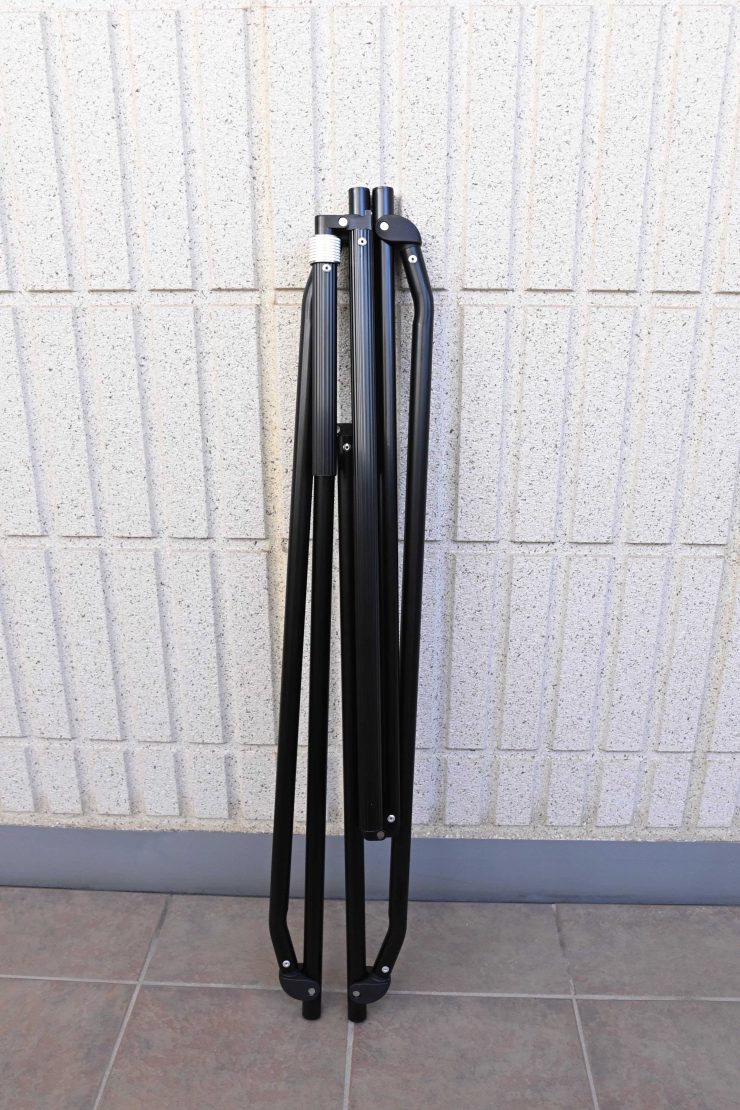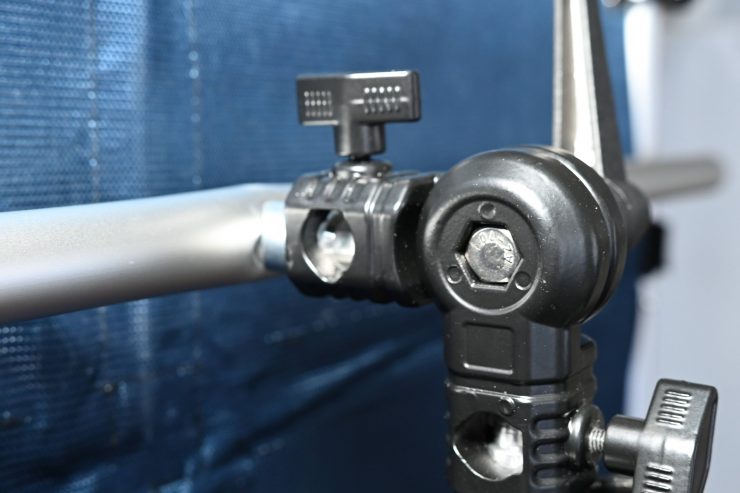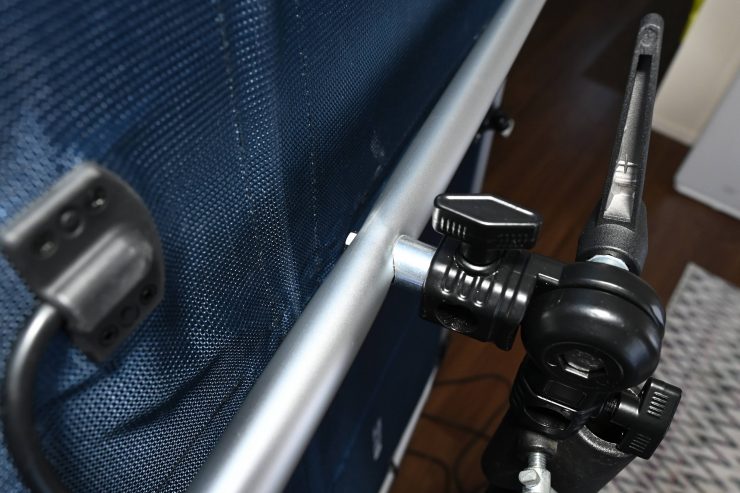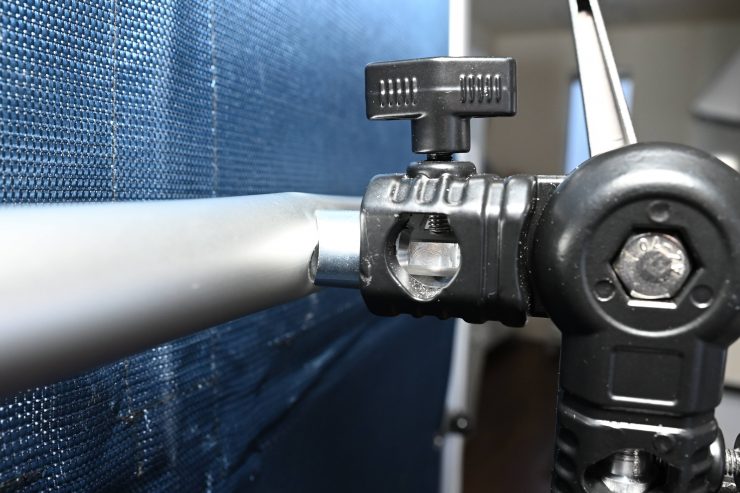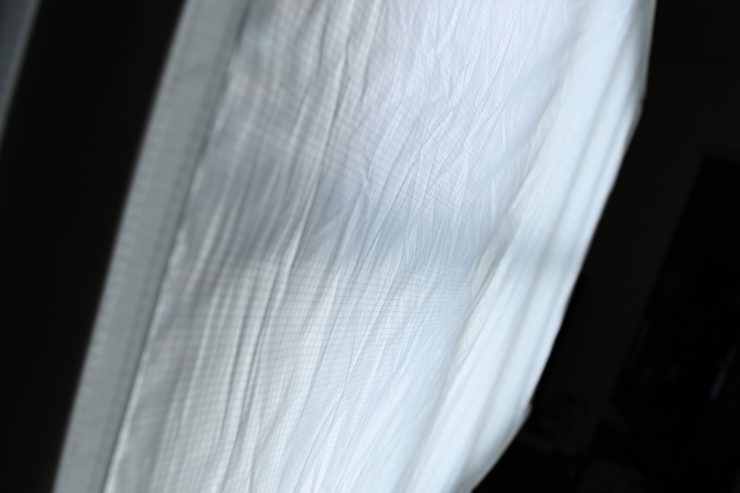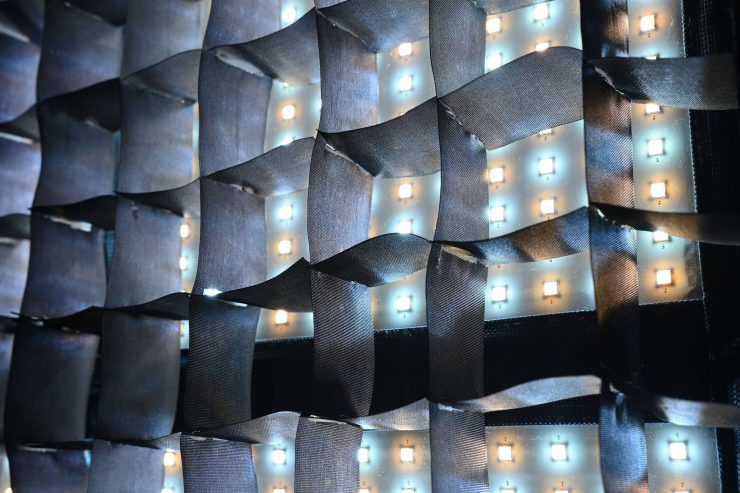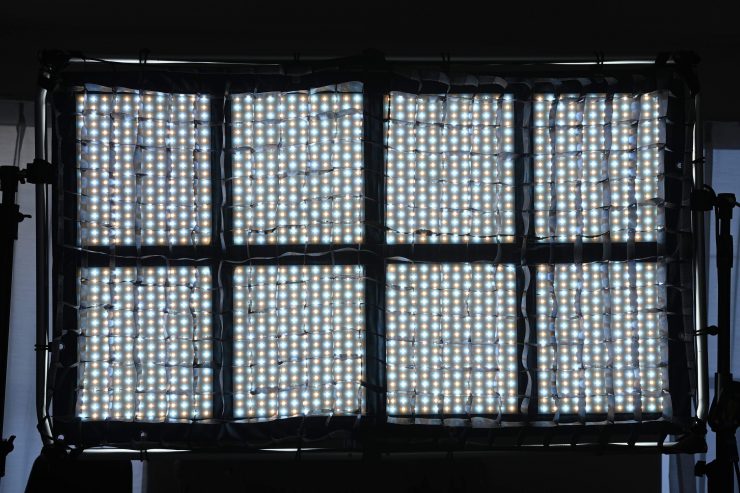
The Intellytech MEGA-8 LITECLOTH 3.0 is a large, flexible LED light that has the versatility to be used for a wide range of lighting applications.
The LITECLOTH lineup is a fast and effective way to get broad and soft lighting on set and they break down into a reasonable size for traveling. The new version is available in both Bi-color and RGBWW. The previous version was only available in Bi-color.
The MEGA-8 LITECLOTH 3.0 was first shown at NAB 2023. Above you can see our interview from the show. The light is CCT adjustable from 3000K to 9999K.
I previously reviewed the Intellytech MEGA-LiteCloth 3’x 4.5′ Foldable LED Mat Kit on the site back in 2020. I really like this light and I have used it on a lot of productions. It has been one of the staples in my lighting arsenal. While this was one of my favorite fixtures, there were a few design elements that I thought could have been better.
The new version looks to be much improved over the previous offering. It features a much more robust frame, a more convenient tie-down solution, a more compact power supply/controller, and more output. This is much more than just a small refresh. Intellytech has redesigned almost everything.
Key features
- For Studio & Film/TV Production
- Output: 9990 Lux at 3.3′ (5600K)
- 3000-9999K; Bi-Color & RGB Control
- 3 x 5′; AC/DC Operation
- CRI 97 | TLCI 99
- Onboard, DMX & LiteSync+ App Control
- Multi-Voltage AC, V-Mount Plate
- Includes Softbox & Grid, Diffuser, Case
Going Large
Intellytech originally released 1′ x 3′ and 2′ x 2′ Foldable LED Mat Kits way back in the day. The new MEGA-8 LITECLOTH 3.0, just like the first MEGA-LiteCloth 3’x 4.5′, dwarfs both of those lights by a considerable margin. The MEGA-8 LITECLOTH 3.0 is one of the largest foldable LED lights available on the market.
Big size, small to travel with?
With most large lighting fixtures you can’t have your cake and eat it too. There is always going to be a compromise that you have to make, and this even applies to foldable and flexible light mats.
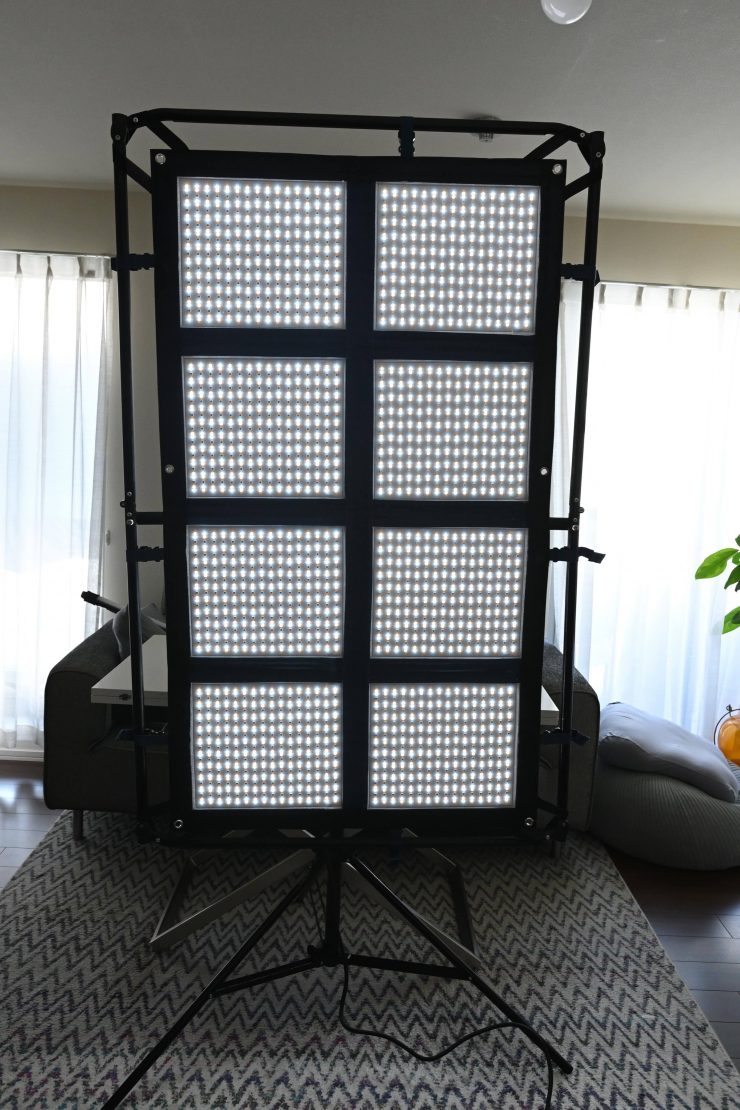
The MEGA-8 LITECLOTH 3.0 is essentially 8 1×1 panels that are combined to create a single large lighting source. When folded out, the fixture has a footprint of 57″ x 33″ / 144.8 x 83.8 cm.
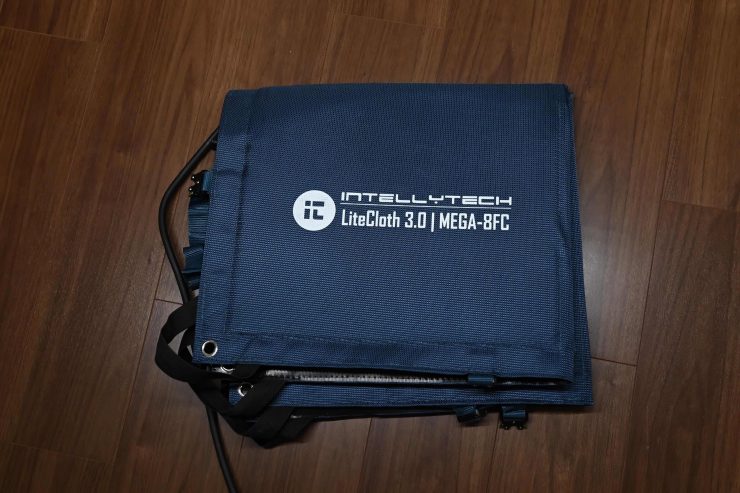
The Intellyech MEGA-8 LITECLOTH 3.0 folds down to a 14″ x 16″ x 1″ square. The design allows the user to create a broad, bright, natural-looking light in a relatively easy to travel with package that can be set up reasonably quickly.
I say relatively easy to travel with package because you still have to factor in the size of the frame and the weight and the size of the power supply. This is the caveat to owning one of these large foldable LED mats.
The MEGA-8 LITECLOTH 3.0 weighs in at 12 lb / 5.4kg (Fixture with Frame). The power supply/controller weighs 6.2 lb / 2.8kg. The entire kit in its case weighs 46 lb / 20.9 kg.
| WEIGHT (Controller/Power Supply & Panel) | |
| Intellytech MEGA-8 LITECLOTH 3.0 | 18.2lb / 8.2kg (includes frame) |
| Aladdin MOSAIC 3×6 RGBWW LED Panel Kit | 22 lb / 10 kg (without Frame) |
| Godox 600Bi Bi-Color LED Light Panel | 17 lb / 7.7kg |
So how does this weight compare to some other competing solutions on the market? Well, above you can see.
With the previous version, I actually ended up ditching the case it came in because it ended up breaking and I found it to be too big. Instead, I put the frame and diffusion screen in a padded lightweight light stand bag. I then put the flexible panel and the power supply/controller into a Pelican case.
If you were going to be traveling with the light and taking a lot of flights you could potentially ditch the frame and simply use other methods to hold the light up.
Lots of power

The Intellytech MEGA-8 LITECLOTH 3.0 is the most powerful fixture Intellytech has ever made. It draws 400W and it can be run via camera batteries. The previous version had a 300W power draw.
With the new version, you can’t run the fixture from two flight-safe batteries as it requires 400W. This was something that was possible with the older version.
The competing Aladdin MOSAIC 3×6 RGBWW LED Panel Kit draws 600W and the Godox 600Bi Bi-Color LED Light Panel draws 670W.
What do you get?
The lighting kit consists of:
- Intellytech Mega-8FC Litecloth 3.0 RGB LED Flexible Mat (V-Mount)
- Softbox
- Diffuser
- Grid
- Mounting Frame
- 5/8″ Clamp
- V-Mount Battery Plate
- Control Box
- Carrying Case
- Limited 1-Year Manufacturer Warranty
Now, you need to be aware that this case with everything inside it weighs in at 20.9 kg (46 lb). The weight has increased from the previous version which weighed in at 16 kg (35.2 lb).


New case 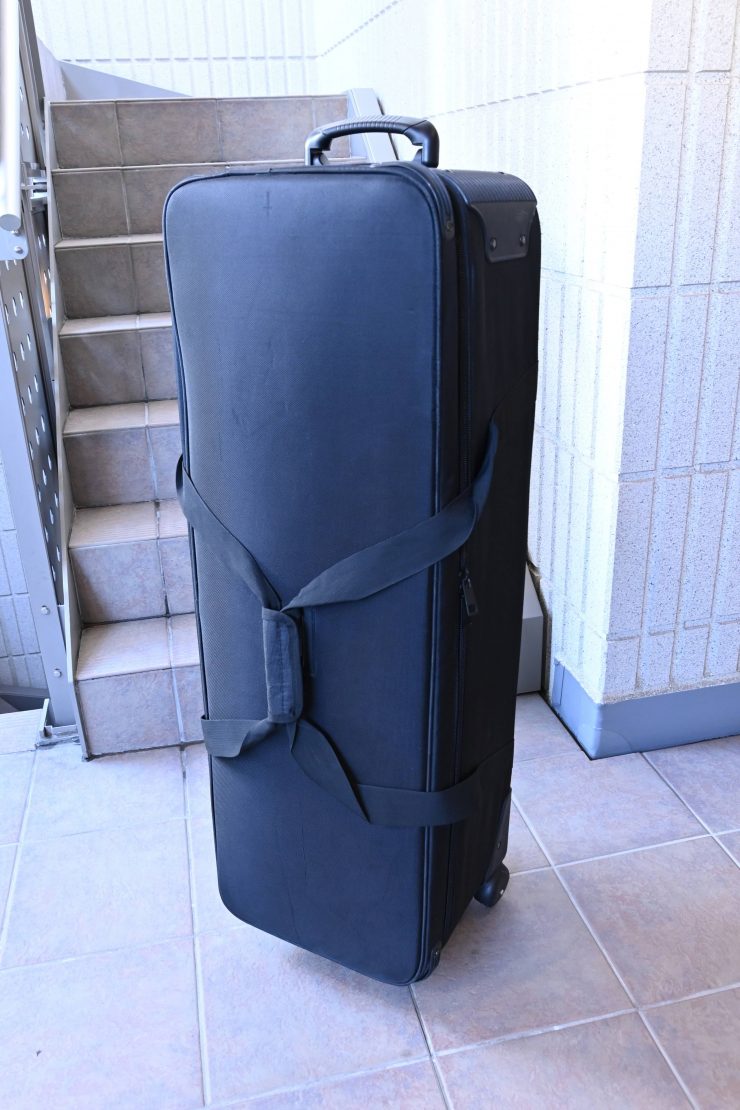
Original case
The case it comes in is similar to the original version, but it looks to be slightly better made.

I’m not quite sure how it would handle the rigors of air travel. You would have to take numerous flights to see how it held up. Realistically, nobody should be complaining about getting a case for free, as usually a case this size would not be included as standard with a light and it would cost hundreds of dollars to purchase separately.

In my personal opinion, the case makes a lot of sense because it allows you to keep everything you need together. With the original version of the light, the case was long for one reason and one reason only, which was to fit the fast frame. As you always need light stands I personally put the fast frame in with my light stands and keep the light and power supply in a much smaller bag. Now, with the new version, the diffuser frame is different and it isn’t as easy to fold down, so it probably does make more sense to use the case.
I can, however, appreciate why Intellytech wanted to give customers a case that could fit everything in it. The nice thing is, you can use it if you want, or if you prefer another option you can decide what works best for you.
If you are going to use the case then I would put other items inside there to maximize the space when travelling.
RGBWW

It is nice to have RGWW capabilities with the new MEGA-8 LITECLOTH 3.0. It just further increases its versatility.
Build Quality

The overall build quality of the MEGA-8 3.0 is pretty good and a lot of improvements have been made over the original offering.

The new power supply/control unit is robustly constructed and all of the connections are good. As I previously mentioned, Intellytech did a complete redesign of the power supply/controller.
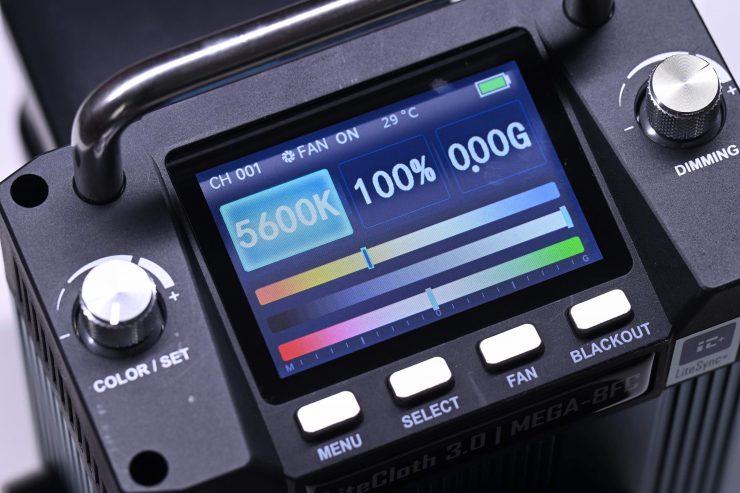
There is now a much larger color display which is easier to see. I personally think that the display graphics do look a little on the cheap side, but I am being very picky here. It does its job and it is easy to see what your operating parameters are.
The buttons and dials are tactile and easy to use.
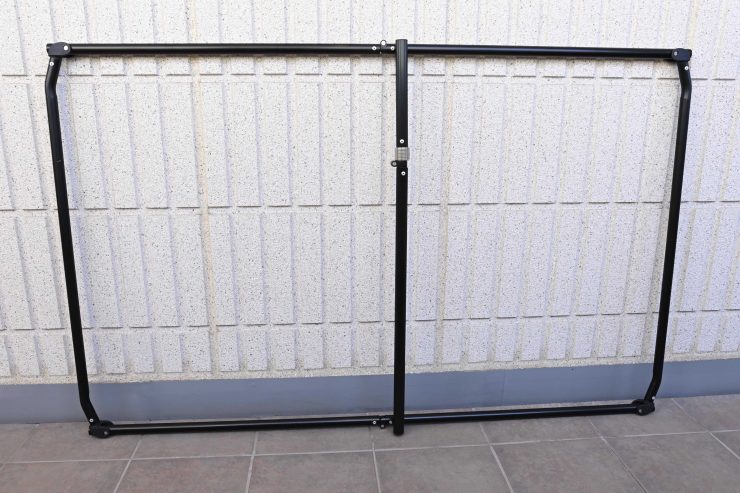
The fast frame has been designed to be lightweight and portable, so usually that requires a compromise between weight and rigidity. However, the redesigned frame is more rigid and robust than the previous version.
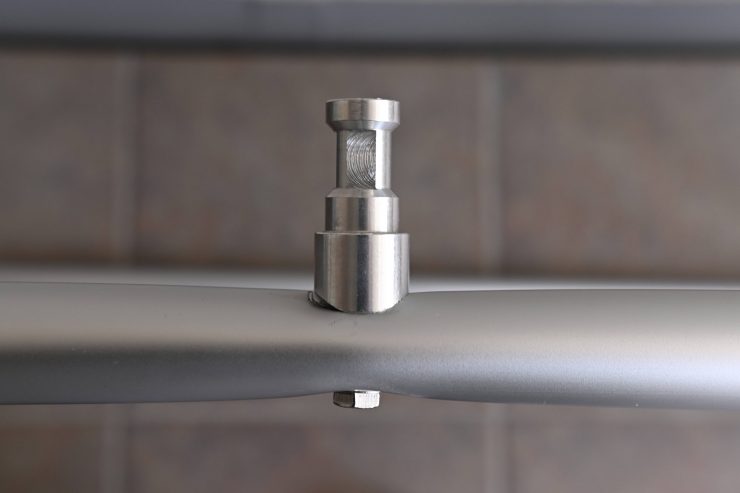
The biggest design flaw the previous version had was that the attachment pin was fixed on the fast frame. All of the weight was being placed onto this lightweight pin and because it wasn’t in the center of the frame, the light would always lean badly to one side. I was also always worried that this was going to break and it constantly came loose and needed tightening.

To their credit, Intellytech went back to the drawing board and they ditched that attachment pin on the frame. The light now comes with a very robust mounting clamp that you can position anywhere along the middle section of the frame. This is a way better solution.
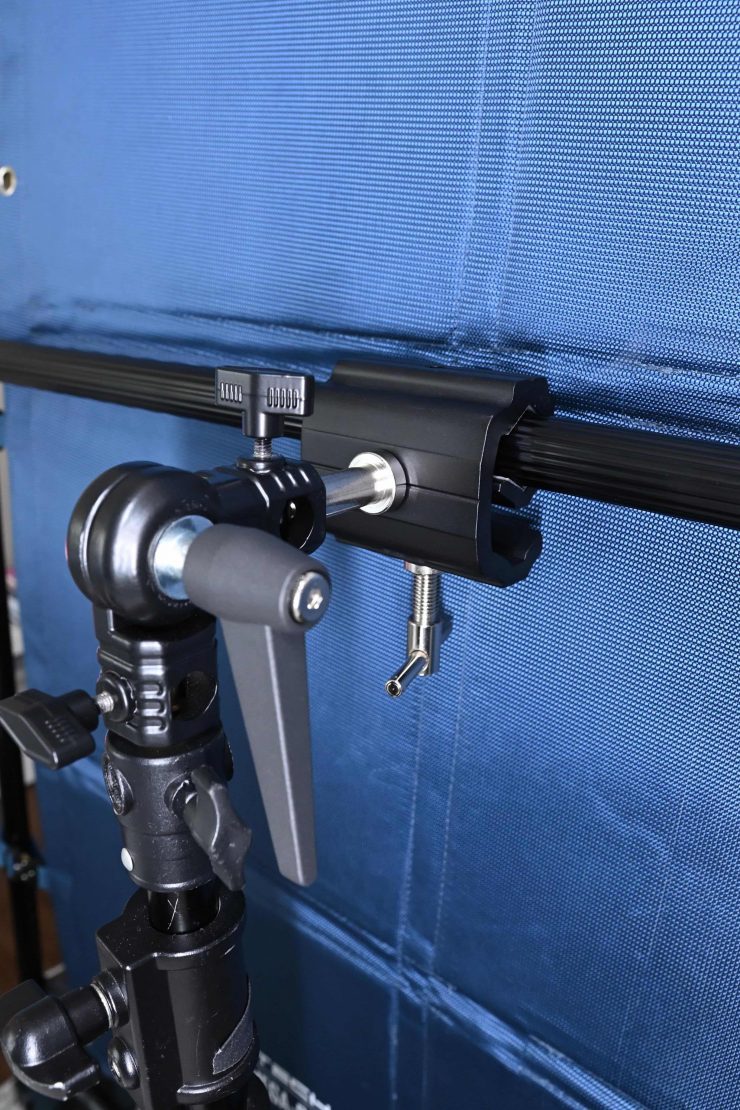
On the end of the mounting clamp, there is an attachment pin for putting into the angled mounting bracket that then attaches to a light stand. One of the problems I encountered was that if you are placing the light horizontally because there is a lot of weight and the middle supporting rod on the frame isn’t in the middle, the light would always end up leaning slightly to one side. This isn’t a huge deal, but it is something I noticed.

If you are mounting the light vertically instead of horizontally, the new mounting clamp can be moved along the center rail to create a better balance.

The other added benefit is that you can now also angle the light, by simply adjusting the mounting clamp.
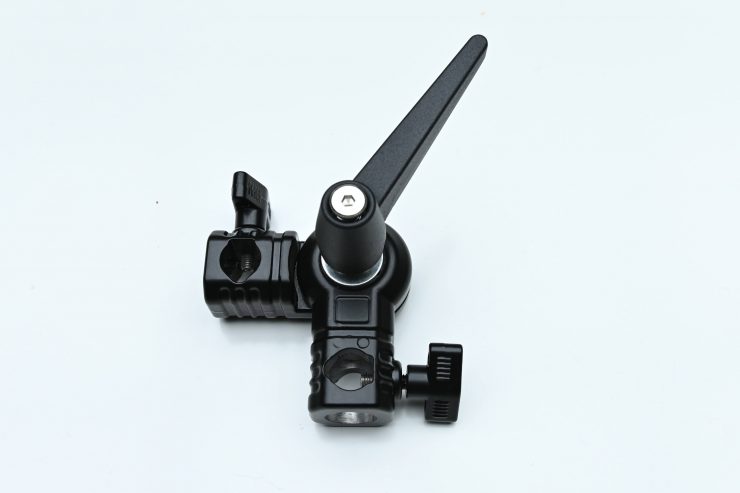
The included mounting bracket is reasonably heavy duty and it does allow you to angle the light in a lot of directions.
Controller & Power Supply

The Intellyech MEGA-8 LITECLOTH 3.0 has a power supply/controller with a built-in AC adapter.


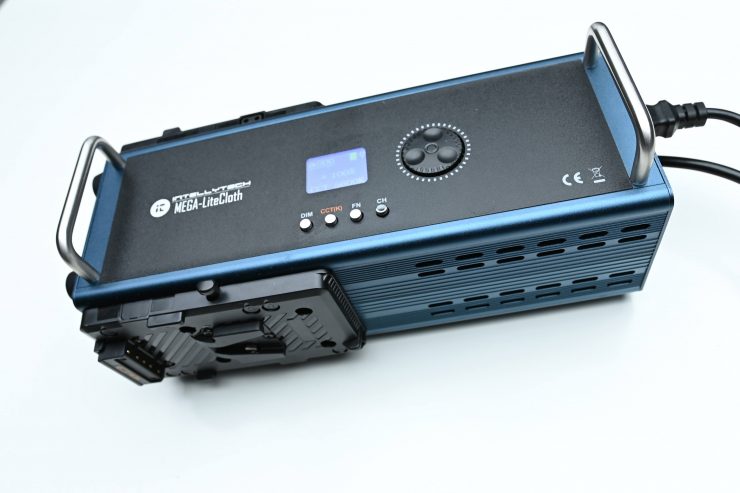
The old power supply/controller
The power supply/controller has gone through a complete redesign and it looks quite different from the original one.


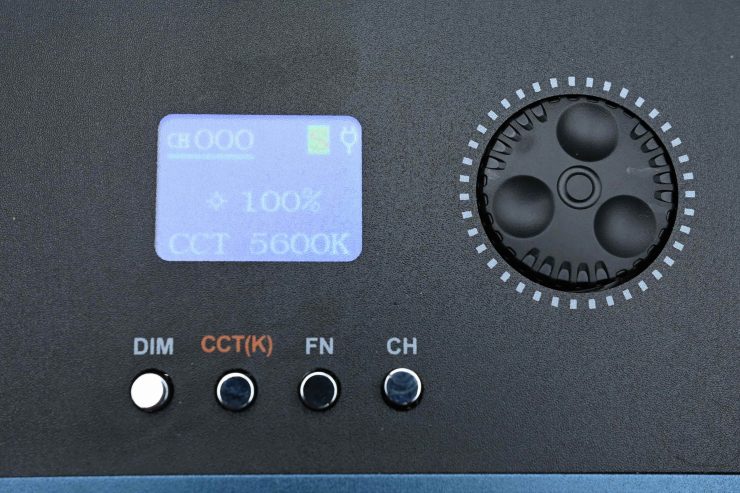
The old power supply/controller
The power supply/controller is reasonably intuitive and straightforward to use. You can clearly see all of the parameters on the display screen. It is much more intuitive and easy to see than the old version and the display is now on top of the power supply/controller instead of the side.

The power supply/controller also has a little V-mount style receptor quick-release plate on the side.

This allows you to mount the power supply/controller directly to a lightstand using the included bracket that comes in the kit. This works really well and it is a nice stable and solid connection.
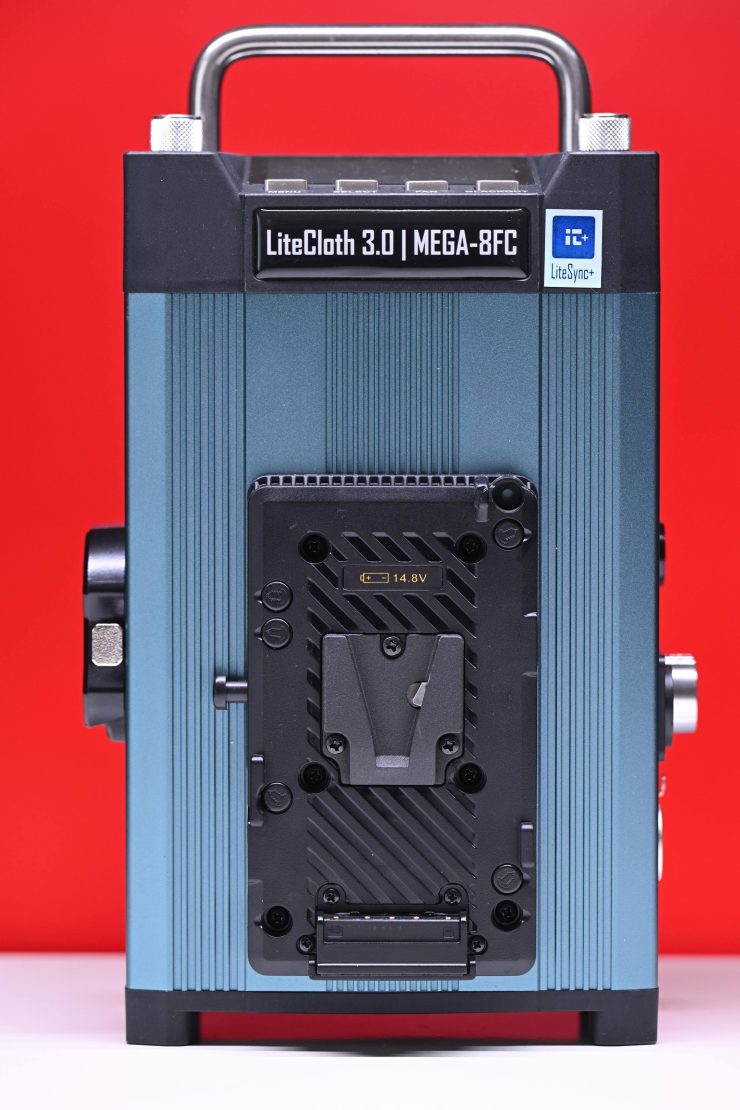
It also has either two V-Lock or two AB Gold Mount battery plates depending on which version you choose.

While you can power the light from camera batteries, it’s important to note that two high-capacity batteries are required due to the high power draw. Each battery should be at least 200Wh and 10.5Ah or higher.

I tried using a single SWIT PB-C420S 420Wh Large Capacity V-mount Battery, but it wouldn’t work. As I just mentioned, you need to attach two batteries.
In a nice touch, the power supply/controller has built-in circuit protection, so if you try and use it with incompatible batteries it will shut itself off to prevent any damage.
As I mentioned earlier, one of the appeals of the previous version was that you could power it from two flight-safe batteries. If you are traveling a lot then you need to consider carefully whether the Intellyech MEGA-8 LITECLOTH 3.0 will work for you, especially if you need to regularly run it from flight-safe batteries.

What is nice with the new power supply/controller is that it has a 3-pin 48V DC input so you could run it off something like the SWIT TD-R230S 48V 750W Light Stand Power Adapter and a couple of high capacity 28.8V V-mount batteries. This is a great solution because you can run the MEGA-8 at 100% output continually for more than 2 hours without needing mains power.

The power supply/controller isn’t too large or too heavy, especially considering it is powering what are essentially 8 1×1-sized panels. I weighed the power supply/controller at 6.2 lb / 2.8 kg.
Flexible and foldable LED mats are great because they are compact and lightweight, but they still require power like any other light. They can’t magically produce a lot of output without a fairly large power supply.
The Intellyech MEGA-8 LITECLOTH 3.0 is ready for worldwide use via its universal 110-240v AC power supply.

The Power Supply/Controller has the following inputs & outputs:
- 1 x XLR 3-Pin Male Battery/Power Input (48 VDC)
- 1 x USB-C Female Service Input
- 1 x powerCON AC Power Input (110 to 240 VAC, 50 / 60 Hz)
- 1 x XLR 5-Pin Male DMX Input
- 1 x XLR 5-Pin Female DMX Output

There is a 5-Pin XLR DMX In and DMX 0ut. Additionally, there is a USB-C Port that can power wireless DMX transmitters or any device up to 2W. You can also use it to update firmware.

The power supply/controller does have an in-built fan that you can turn on or off.

The fan noise is basically non-existent and I couldn’t really tell the difference when it was on or off. The light is extremely quiet which is fantastic.
Intellytech does sell optional 20′ or 32′ LiteCloth Extension Cables that go between the light and the power supply/controller so you can move the unit further away from the light if need be. I would recommend getting one of these.
Control

The power supply/controller has separate dials for Color/Set and Dimming.

There are also four buttons:
- MENU
- SELECT
- FAN
- BLACKOUT

You make adjustments by using a combination of the dials and buttons. This is all fairly intuitive and easy to do.

The Menu button brings you to the above screen where you can toggle through and select the various operating modes, etc. You use the COLOR/SET dial to go between the various modes and then the SELECT button to enter that mode.

In the FX mode, you can choose between various lighting effects as well as change their speed.

In the RGB mode, you can individually adjust, you guessed it, the Red, Green, and Blue channels.

In HSI mode, you can adjust Hue, Saturation, and Intensity.

If you choose BT Set, you can reset the Bluetooth ID that is used for the LiteSync+ app that I will talk about later.

DMX Set allows you to turn on/off DMX RF groups, adjust the DMX channel and choose how you want to use DMX.

In the Gel Set mode, you can choose between a select number of gels. While there isn’t a massive range to choose from, most people will be happy with it.

Dimming mode, as its name would suggest, allows you to change the light’s dimming characteristics.

If you press the BLACKOUT button, the light turns off while it is still powered up.

The FAN button, just simply toggles the fan on or off. There are no other fan settings available.
LiteSync+ Andriod & iOS Bluetooth app
As well as making adjustments directly from the power supply/controller you can also use the free LiteSync+ Andriod & iOS Bluetooth app to control the light remotely.

Now, I don’t like apps where you need to register and provide details. Unfortunately, that is what you need to do if you want to use the LiteSync+ app.

When you first launch the app you will need to add the MEGA-8 LITECLOTH 3.0. You do this by tapping on the large + button.

Once your light has been found, you can then click on it to access the settings.

You will then be greeted by the above screen. Here you can make changes and access modes. Now strangely, the app shows that you can set the light at 2500K, but the light only goes as low as 3000K.

You can quickly adjust CCT, brightness, and G/M +/- here. There is also the ability to quickly press preset CCT settings.

If you want to there is also the ability to physically type in CCT and brightness values.

In the HSI section, you can dial in hue, saturation, and intensity as well as choose from preset colors.

Intellytech also gives you the ability to save your own custom colors. You just create the color you want and then hit + and it will be saved. To get rid of it you can just press on the – symbol.

In the RGB section, you can manually control the individual red, green, and blue channels.

In the Coloured Gels section, you can choose from a select number of gels. While the range isn’t huge, most people should be happy with it.

There is also a Music mode, where he light will pulse along with included music tracks. You can also use your smartphone’s inbuilt microphone to get the light to do this with any music you are playing.

Like most apps these days, you can use your smartphone’s camera to sample a color that the light will then attempt to replicate.

This works reasonably well, but it really depends on what color you are trying to sample as to the results you will get.

You can also save and recall lighting presets, which is also handy.
Overall, the app is pretty good. It is intuitive and responsive, and the UI makes everything clear and concise.
Set-Up Time & Usability


Unfolded 
Folded
The biggest downside of using most flexible or foldable LED lights is that they are a pain to set up. You normally have to construct up frames and mounts and then hook them up to controller units and power supplies.
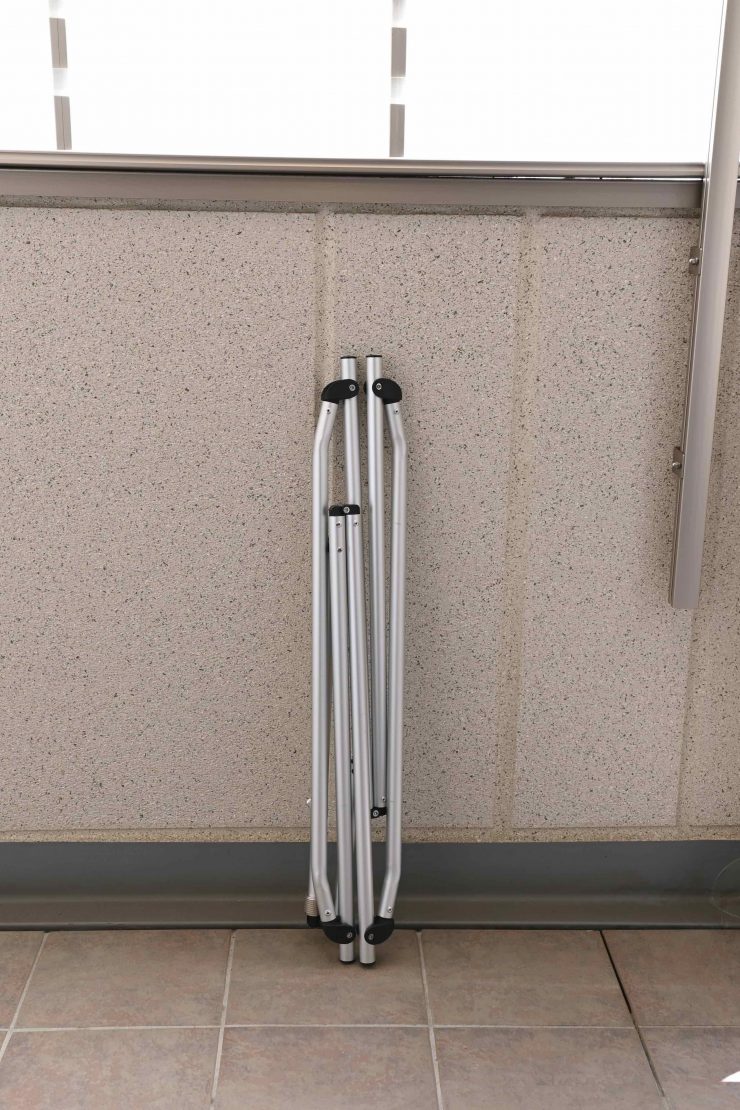

Old Frame 
New frame
The Intellytech uses a quick and intuitive frame, that while similar to the previous version, has been redesigned. It is now more robust and black instead of silver.

The included frame uses a similar design as Intellytech’s Fast Frames. It simply folds and unfolds into place, requiring no assembly.

It can be assembled in seconds and there is only one locking mechanism that you need to tighten on the frame.

The frame is lightweight, but also very sturdy and robust.
I love the design of these Fast Frames, and it is one of the main reasons the Intellytech FF-5×6.5’HC Fast Frame Scrim Diffuser with Grid and Diffusion is one of my go-to lighting tools.

Because of the size of these frames, you can also get away with using the light without any lightstands if you have something to rest it on.
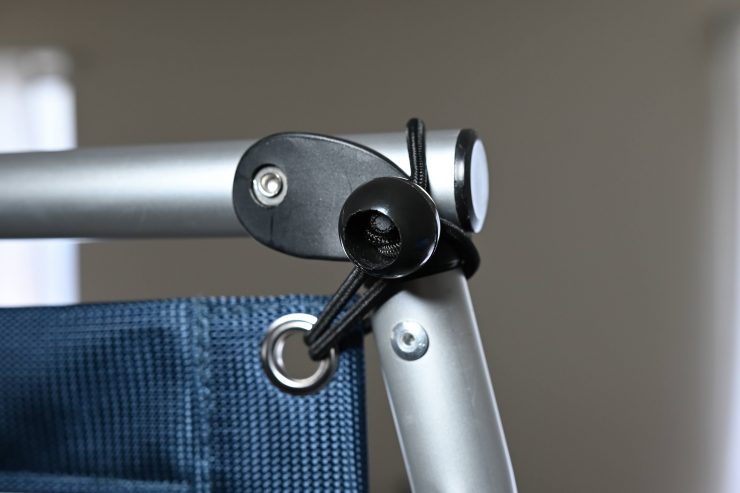
With the older version, you needed to attach the LED Mat to the frame using bongo-style ties and grommets. This could be fiddly and time-consuming.

With the MEGA-8 LITECLOTH 3.0, Intellytech has kept the grommets but added integrated metal clips. You use these by passing one side around the frame and then locking it into the other side. These are solidly made and work well.

This certainly allows for a tighter connection and you can pull on the straps to tighten the LED Mat.

The LITECLOTH also has elastic on all four corners that you also use to help attach it to the frame.

As the light still has the grommets, you could use those for mounting purposes as well if you wanted to.

I found it quicker to attach the LED Mat to the frame when it was laid out horizontally or resting on the ground. The LED Mat, while still reasonably light, does have some weight to it and if you try and attach it to the frame by yourself when it is sitting vertically it can be a little difficult to do. If you are setting up the light by yourself it is easier if you attach all of the elastic straps to all four corners first and then work your way around and do up the clips.

If you are working by yourself or in a small crew you need to be able to set up lighting quickly. The MEGA-8 LITECLOTH 3.0 is not something you can set up in 60 seconds, you are going to have to factor in around 5 minutes to set it up, slightly longer if you want to attach the diffusion or honeycomb grid.

Speaking of the diffusion, it now needs to be attached to a fold-out mounting frame that you need to attach to the LED Mat using velcro. With the old diffusion, it was integrated into a flexible frame with elastic straps that you could unfold and attach in 30 seconds. With the new version, this is now significantly slower as you need to attach the diffusion frame and then put the diffusion on. This adds extra time to the set-up process. Because it is also reasonably heavy, I found it best to attach it while the light was sitting horizontally on the ground. If you try and put it on when the light is already on a light stand and sitting vertically it can be tricky.
Now, you may be wondering, why make this process of attaching the diffusion more complicated and time-consuming? Well, the main reason is that to get a nice soft source, the diffusion needs to be placed away from the actual LED source.
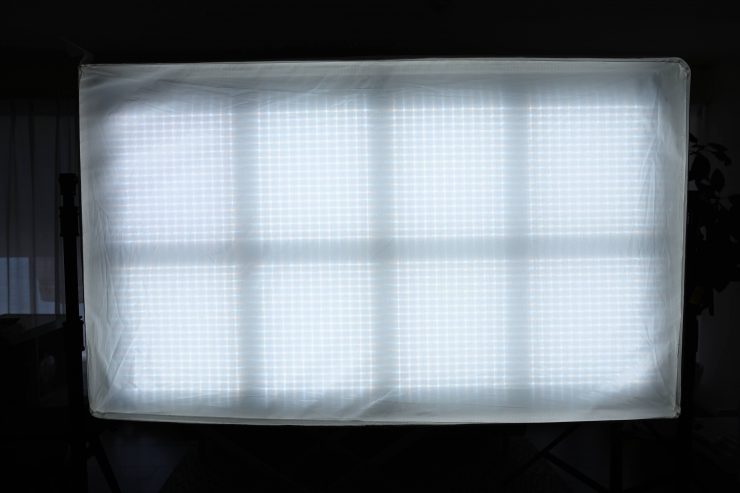
With the previous version, the diffusion was literally sitting almost directly on top of the LEDs. As it was only 1/2 stop diffusion, it was only diffusing the light so much.

With the new system, Intellytech has created depth, which really helps in creating a lot softer source.

You also get a honeycomb grid in the kit. This works a lot better than it did with the original version as you attach it to the front of the flexible diffusion frame. Unlike the old version, the new honeycomb grid is actually a lot more rigid. As the light has quite a broad spread of light, the honeycomb grid does a good job of limiting unwanted spill.
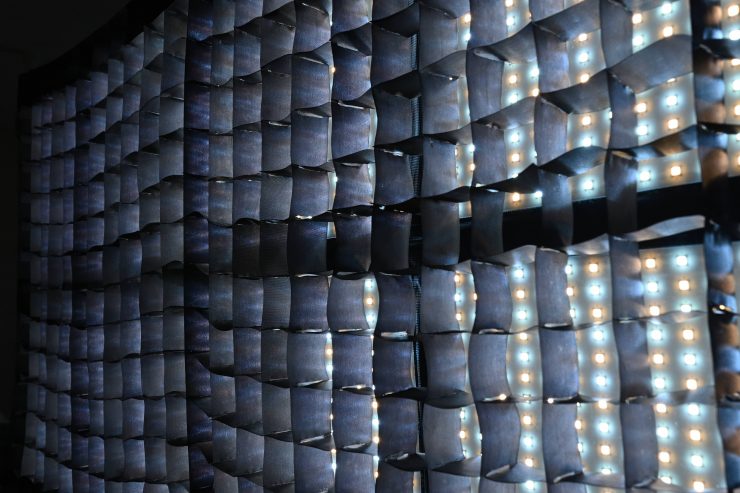
The problem I found with the original light was that honeycomb grid couldn’t really be used with the diffusion. You need to use one or the other. I tried putting the honeycomb grid over the top of the diffusion, but it didn’t fit.
One of the downsides, as I mentioned earlier, is you have to carry around a reasonably large controller/power supply. The included case the kit comes in certainly isn’t small either. The nice thing is you don’t have to use that case if you don’t want to. You could take out the individual components and pack them separately if need be. This was something I did with the older version.

I found that you could use the light by just attaching it to one or two light stands and not use the frame. The position of the light will still stay fairly flat even without using the frame. Unlike the previous version, you can still attach the diffusion when doing this. With the old light, to use the diffusion you needed to use the frame.
As the MEGA-8 LITECLOTH 3.0 is so large you can also fold it around into two sides so you can effectively light two different directions at once. I will show you how this works further down in the review.
The great aspect of flexible lights is your ability to shape them and manipulate them to create unique light sources.
What I also love about this light is you can use components from the kit with other lights and as lighting accessories. The diffuser can be used with any other type of light and because of its size and the fact that it remains reasonably rigid when folded out. You could easily clip it to a light stand or two and punch another light through it.
The frame can also be used if you just wanted to place your own diffusion on it and use it with another light.
Output & Color Temperature Accuracy

A big factor for a lot of people when buying a light is how much output it can produce.

Intellytech claims that the light puts out around 9,800 lux @ 1 meter when it is set at 5600K. The previous Bi-Color version put out around 8,000 lux @1m. What you do need to clearly remember is that the previous version drew 300W, while the new one draws 400W.
Well, let’s put that output claim to the test. I tested the lights output at a variety of CCT settings both running on mains and battery power using a Sekonic C-800 at a distance of 1m (3.28ft) in a controlled environment; you can see the results below. With any diffusion or attachment, I measure from the end of it and not from the light source. I do this with all my measurements for lights.
Intellytech MEGA-8 LITECLOTH 3.0 5600K Open Face

Above you can see the MEGA-8 LITECLOTH 3.0 recorded an output of 11,100 lx (1040 fc) when set at 5600K and run off mains power. This is more than the claimed output of 9900 lx from the manufacturer. 11,100 lx from a flexible LED light of this size is impressive.
As a comparison the 2.0 Bi-color version recorded an output of exactly 8000 lx (744 fc) when set at 5600K and run off mains power

The MEGA-8 LITECLOTH 3.0 produced a CCT reading of 5531K, which was reasonably good.
Again, as a comparison, the previous version produced a CCT reading of 5592K.
Intellytech MEGA-8 LITECLOTH 3.0 3200K Open Face

Above you can see the light’s output when it was set at 3200K. It produced 10,500 lx (602 fc), which is just 5.4% less than the 11,100 lx it produced at 5600K.
As a comparison, the 2.0 Bi-color version recorded an output of 6480lx (602 fc) when set at 5600K and run off mains power.

As far as CCT accuracy goes, it recorded an extremely accurate reading of 3207K. The light is more CCT-accurate at 3200K than it is at 5600K.
Again, as a comparison, the previous version produced a CCT reading of 3299K.
How does it perform at various CCT settings when used Open Face?
Intellytech MEGA-8 LITECLOTH 3.0
| OUTPUT | CCT | |
| 3000K | 10,400 lx | 3032K |
| 3200K | 10,500 lx | 3207K |
| 4500K | 10,900 lx | 4421K |
| 5600K | 11,100 lx | 5531K |
| 6500K | 11,200 lx | 6424K |
| 8000K | 11,400 lx | 7876K |
| 9999K | 11,300 lx | 9826K |
The light has a very consistent output when used at any of its CCT settings. The output across its CCT range only varied by 8.77%. This was impressive and exactly what I want to see from a light.
The results also show me that the light is pretty accurate when it comes to CCT reproduction from 3000-6500K. Only at 8000K and 9999K was it a little off. The CCT was no more than 79K off from 3000-6500K.
Intellytech MEGA-LiteCloth 3’x 4.5′ 2.0
| OUTPUT | CCT | |
| 3000K | 5870 lx | 3037K |
| 3200K | 6480 lx | 3299K |
| 4500K | 7430 lx | 4544K |
| 5600K | 8000 lx | 5592K |
| 6500K | 7890 lx | 6445K |
| 9999K | 7370 lx | 9224K |
As a comparison, above are the same results for the original Intellytech MEGA-LiteCloth 3’x 4.5′. As you can see, the output varies by 26.6% which is a lot more than the 8.77% of the MEGA-8 LITECLOTH 3.0.
One thing I did notice is that the MEGA-LiteCloth 3’x 4.5′ 2.0 was more consistent than the new version when it came to CCT accuracy across its entire range.
Intellytech MEGA-8 LITECLOTH 3.0 5600K 1/2 Stop Diffusion

Above you can see that when the light had diffusion attached it recorded an output of 8440 lx (784 fc). This was 20.3% less output than when using the light open face.

Now, just like with the original light, the diffusion does alter the CCT by quite a considerable margin. With the diffusion, the CCT reading was 5260K which was almost 300K different from the 5551K it recorded with no diffusion. This is something to keep in mind, because you may want to increase the color temperature slightly on the controller to compensate for this.
With this in mind, I decided to do some further testing to see what CCT I actually had to set the light to when using the diffusion to recreate an accurate 5600K source.

Above you can see that I set the CCT to 5950K.
Intellytech MEGA-8 LITECLOTH 3.0 5600K 1/1 Stop Diffusion (Corrected CCT)

After setting the CCT to 5950K, I got the above result. As you can see, I got a CCT of 5613K which was almost perfect. This shows you one of the advantages of owning something like a Sekonic C-800-U. I could take readings and then make adjustments to the light.
Intellytech MEGA-8 LITECLOTH 3.0 3200K 1/2 Stop Diffusion

Above you can see the light’s output when it was set at 3200K and using the diffusion was 8030 lx (746 fc), which was 23.5% less than the 10,500 lx it produced when used open face.

As far as CCT accuracy goes, it recorded a reasonably accurate reading of 3250K. Unlike at 5600K, the reading at 3200K when using diffusion didn’t get altered in a drastic way.
How does it perform at various CCT settings when used with Diffusion?
Intellytech MEGA-8 LITECLOTH 3.0 1/2 Stop Diffusion
| OUTPUT | CCT | |
| 3000K | 7870 lx | 2986K |
| 3200K | 8030 lx | 3250K |
| 4500K | 8160 lx | 4280K |
| 5600K | 8440 lx | 5260K |
| 6500K | 8380 lx | 6093K |
| 9999K | 8380 lx | 9027K |
The results show me that the light’s CCT accuracy when using the diffusion starts to get massively altered once you get to 4500K and above. Yes, anytime you put anything in front of a light it will alter the CCT, but nonetheless, this is something you need to be very aware of.
Intellytech MEGA-8 LITECLOTH 3.0 5600K 1.5 Stops Diffusion
Ok, so now let’s see when I add another layer of diffusion to the front of the light so we now have 1.5 stops of diffusion.

Above you can see that when the light had diffusion attached it recorded an output of 5720 lx (532 fc). This was 48.46% less output than when using the light open face.

It was no surprise that two layers of diffusion ended up massively altering the CCT reading. With two pieces of diffusion, the CCT reading was 5078K which was 473K different from the 5551K it recorded with no diffusion.
Again, with this in mind, I decided to do some further testing to see what CCT I actually had to set the light to when using the diffusion to recreate an accurate 5600K source.

Above you can see that I set the CCT to 6200K.
Intellytech MEGA-8 LITECLOTH 3.0 5600K 1.5 Stops Diffusion (Corrected CCT)

After setting the CCT to 6200K, I got the above result. As you can see, I got a CCT of 5616K which was very, very accurate. Again, this shows you one of the advantages of owning something like a Sekonic C-800-U. I could take readings and then make adjustments to the light.
Intellytech MEGA-8 LITECLOTH 3.0 3200K 1.5 Stops Diffusion

Above you can see the light’s output when it was set at 3200K and using 1.5 stops of diffusion was 5350 lx (497 fc), which was 49.04% less than the 10,500 lx it produced when used open face.

As far as CCT accuracy goes, it recorded a reasonably accurate reading of 3113K. Again, unlike at 5600K, the reading at 3200K when using two pieces of diffusion didn’t get altered in a drastic way.
Intellytech MEGA-8 LITECLOTH 3.0 5600K Lantern
Ok, so let’s now see how it performs when using the optional Lantern.

Above you can see the MEGA-8 LITECLOTH 3.0 recorded an output of 3810 lx (354 fc) when set at 5600K and used with its optional Lantern. Now, please note that I am taking this measurement at a distance of 1m / 3.3′ from the end of the Lantern and not from where the LED mat is.

The MEGA-8 LITECLOTH 3.0 produced a CCT reading of 5126K when used with its Lantern which was a bad result. Just like when using diffusion, the Lanern massively alters the CCT. At 3200K it was fine.
CCT consistency & linear output when dimming the light
Now, what you should always do when testing lights is to see if the CCT remains consistent when dimming the light. Just because you set a light at say 5600K, that doesn’t mean that the CCT will remain stable as you start dimming the fixture down. I also wanted to see how linear the dimming curve was.
I decided to do a series of tests at 100%/75%/50%/25%10% to see if the CCT being recorded changed. This was done at a distance of 1m / 3.3′ using a Sekonic C-800. These tests were done at 5600K with the light being used open face.
| CCT READING | OUTPUT | INTENSITY % |
| 5531K | 11,100 lx | 100 |
| 5521K | 8340 lx | 75 |
| 5536K | 5530 lx | 50 |
| 5569K | 2730 lx | 25 |
| 5884K | 947 lx | 10 |
The MEGA-8 LITECLOTH 3.0 maintained pretty good CCT consistency as you start dimming the fixture. My testing showed that the CCT readings varied by 48K from 100% to 25%. At 10% it did fall off and there was a difference of 353K compared to when it was used at 100%.
As far as how linear the output is when you start dimming the light, at 50% output it had 50.18% less output than when used at 100%. At 25% it had 75.4% less output than when used at 100%. At 10% output, it had 91.46% less output than when used at 100%. This shows me that the light’s dimming curve is extremely linear.
Output & accuracy when creating saturated colors
I also wanted to test the light to see how it performed when creating a super-saturated Red.
0° – RED

Above you can see that the light recorded an output of 1290 lx (120 fc). What you clearly need to know when using RGB lights like this is that the output levels you can produce when creating super saturated colors are a lot less than when using the light in a CCT mode and vary depending on what color you are creating.

As far as creating an accurate 0° RED, the MEGA-8 LITECLOTH 3.0 recorded a reading of 2° and 100% saturation.
120° – GREEN

Above you can see that the light recorded an output of 3320 lx (308 fc). What you clearly need to know when using RGB lights like this is that the output levels you can produce when creating super saturated colors are a lot less than when using the light in a CCT mode and vary depending on what color you are creating.

As far as creating an accurate 120° GREEN, the MEGA-8 LITECLOTH 3.0 recorded a reading of 120° and 100% saturation.
Color Rendering
So now that we have seen how much output the Mega-8 LiteCloth 3.0 produces, how does it perform when it comes to replicating accurate colors?

Above you can see what Intellytech claims. So let’s put those claims to the test.
Intellytech MEGA-8 LITECLOTH 3.0 5600K Open Face

Above you can see that when the light was set at 5600K and used open face it recorded an average CRI (R1-R8) of 97.8 and an extended CRI (R1-R15) of 96.54. For replicating accurate skin tones it recorded 97.1 for R9 (red), 97.7 for R13 (closest to caucasian skin tones), and 97.0 for R15 (closest to Asian skin tones). These were outstanding results. Only R12 (Blue) was below 90.

The light when set at 5600K also recorded a TLCI score of 99.
As a comparison, I compared the color rendering of the Intellytech to the Aladdin Bi-Flex2 Bi-Color LED Panel 1×2 and the previous Intellytech MEGA-LiteCloth 3’x 4.5′ Foldable LED Mat Kit. The Aladdin has excellent color rendering scores and I personally consider it to be a benchmark for flexible LED panels.
| CRI | EXTENDED CRI | R9 | R13 | R15 | |
| MEGA-8 LITECLOTH 3.0 | 97.9 | 96.54 | 97.1 | 97.7 | 97.0 |
| Aladdin Bi-Flex2 Bi-Color LED Panel 1×2 | 98.5 | 97.54 | 96.7 | 98.6 | 98.8 |
| Intellytech MEGA-LiteCloth 3’x 4.5′ Foldable LED Mat Kit | 96.9 | 95.06 | 85.7 | 97.5 | 95.7 |
Above you can see a head-to-head comparison against the Aladdin Bi-Flex2 Bi-Color LED Panel 1×2 and the Intellytech Mega-LiteCloth when used at 5600K. Despite the large size of the MEGA-8 LITECLOTH 3.0 it stands up very well to the Aladdin, which, as I just mentioned, is what I consider to be the industry benchmark for flexible panel lights when it comes to color accuracy.
Intellytech MEGA-8 LITECLOTH 3.0 3200K Open Face

Above you can see the scores for when the light was used at 3200K open face. It recorded an average CRI (R1-R8) of 98.3 and an extended CRI (R1-R15) of 96.43. For replicating accurate skin tones it recorded 92.8 for R9 (red), 99.8 for R13 (closest to caucasian skin tones), and 98.6 for R15 (closest to Asian skin tones). Just like at 5600K, these are excellent results. Only R12 (Blue) was below 90.

The light, when set at 3200K, recorded a TLCI score of 98.
| CRI | EXTENDED CRI | R9 | R13 | R15 | |
| MEGA-8 LITECLOTH 3.0 | 98.3 | 96.9 | 92.8 | 99.8 | 98.6 |
| Aladdin Bi-Flex2 Bi-Color LED Panel 1×2 | 98.5 | 97.54 | 96.7 | 98.6 | 98.8 |
| Intellytech MEGA-LiteCloth 3’x 4.5′ Foldable LED Mat Kit | 98.1 | 96.43 | 89.4 | 98.6 | 96.8 |
Above you can see a head-to-head comparison against the Aladdin Bi-Flex2 Bi-Color LED Panel 1×2 and the Intellytech Mega-LiteCloth when used at 3200K. Again, just like at 5600K, the Intellytech stands head-to-head with the Aladdin.
Intellytech MEGA-8 LITECLOTH 3.0 5600K Diffusion

Above you can see that when the light was set at 5600K and used with its diffusion it recorded an average CRI (R1-R8) of 98.5 and an extended CRI (R1-R15) of 96.54. For replicating accurate skin tones it recorded 98.9 for R9 (red), 98.9 for R13 (closest to caucasian skin tones), and 98.2 for R15 (closest to Asian skin tones). These were outstanding results. Only R12 (Blue) was below 90.
While the diffusion does affect the CCT reading, it certainly doesn’t have any big effect on the color rendering performance.
CC Index & ⊿uv
The CC Index displays the CC correction value and whether any magenta or green need to be added or subtracted. 1 CC corresponds to 035 Kodak CC values or 1/8 Rosco filter values. Any reading less than +1.00 or -1.00 and you’re probably not going to need to make any kind of adjustment. The ⊿uv is the value to show how much this light is away from being an ideal light source (black body radiation = incandescent lamp). As with the CC Index you want this number to theoretically be zero. Kelvin is not a linear value, so we need to convert from Kelvin to MK-1 to compare the values of color temperature. To calculate from Kelvin to Mired is MK-1= 1*1000000/Kelvin. While this may sound confusing, it is the only way of measuring if the Kelvin shift is significant enough to warrant having to use a filter for correction. Below are the results for the MEGA-8 LITECLOTH 3.0:
MEGA-8 LITECLOTH 3.0 Kelvin Vs MK-1
| Kelvin | Difference in K | MK-1 | Difference in MK-1 | |
| SET VALUE | 3000K | 0 | 333.33 | 0 |
| ACTUAL READING | 3032 | 32 | 329.81 | 3.52 MK-1 |
| SET VALUE | 3200K | 0 | 312.5 | 0 |
| ACTUAL READING | 3207K | 7 | 311.81 | 0.69 MK-1 |
| SET VALUE | 4500K | 0 | 222.22 | 0 |
| ACTUAL READING | 4421K | 79 | 226.19 | -3.97 MK-1 |
| SET VALUE | 5600K | 0 | 178.57 | 0 |
| ACTUAL READING | 5531K | 69 | 180.79 | -2.22 MK-1 |
| SET VALUE | 6500K | 0 | 153.84 | 0 |
| ACTUAL READING | 6425K | 75 | 155.64 | 1.80 MK-1 |
| SET VALUE | 8000K | 0 | 125 | 0 |
| ACTUAL READING | 7876K | 124 | 126.96 | -1.96 MK-1 |
| SET VALUE | 9999K | 0 | 100.01 | 0 |
| ACTUAL READING | 9826K | 174 | 101.77 | -1.76 MK-1 |
These figures might look confusing, but what it tells me is that the light is very CCT-accurate at all of its settings between 2700-9999K. Any MK-1 score that is under -9/9 means you wouldn’t have to use any color correction gels. The MK-1 scores for this light were excellent. Any MK-1 score that is under -6/6 is a very good result.
Ok, now let’s look at the CC INDEX & ⊿uv.
MEGA-8 LITECLOTH 3.0 CC INDEX & ⊿uv
| CC INDEX | ⊿uv | |
| 3000K | 0.2M | 0.0019 |
| 3200K | 0.1M | 0.0004 |
| 4500K | 0.1G | -0.0023 |
| 5600K | 0.1G | -0.0003 |
| 6500K | 0.0 | 0.0018 |
| 8000K | 0.0 | 0.0055 |
| 9999K | 0.1M | 0.0099 |
These were very good results across the board. There was nothing here that anyone should be concerned about and the ⊿uv scores at 3200K and 5600K were outstanding. The light also doesn’t lean green or magenta in any noticeable way across its CCT range. The CC Index scores were right up there with some of the best lights I have reviewed.
TM-30
TM-30 is a relatively new color rendering standard that was developed to deal with the limitations of CRI. TM-30 looks at 99 individual colors. These 99 colors are categorized into seven groups: nature, skin color, textiles, paints, plastics, printed material, and color systems.
TM-30 scores go from 0 – 100. The higher the score, the more accurate a light is at producing colors. Any TM-30 Rf score in the ’90s is considered to be good. What is interesting and something that you need to be very aware of is that two separate light sources with the exact same CRI scores can render colors very differently. A light with a high CRI rating could have a low TM-30 score. Conversely, a light with a good TM-30 score could have a bad CRI score.
Now, there are two measurements associated with TM-30, Rf and Rg.
Rf (Color Fidelity)
Rg (Color Gamut)
With Rf value, ideally, you want a score in the 90’s.
With Rg value, a score below 100 indicates that the light source renders colors with less saturation than the reference source. So ideally you want this score to be above 100.


3000K 
3200K 
4500K 
5600K 
6500K 
8000K 
9999K
Above you can see the scores for the MEGA-8 LITECLOTH 3.0 at various CCT settings. Below I have listed the figures as well.
Here are the results:
| Rf | Rg | |
| 3000K | 96 | 101 |
| 3200K | 96 | 102 |
| 4500K | 95 | 102 |
| 5600K | 95 | 102 |
| 6500K | 95 | 101 |
| 8000K | 93 | 98 |
| 9999K | 90 | 96 |
The TM-30 scores were excellent up to 6500K and it shows me that the light is very consistent at replicating accurate colors with full saturation. However, at 8000K and above the light did struggle a little bit to create full saturation.
SSI
SSI (Spectral Similarity Index) was developed by the Sci-Tech Council of the Academy. SSI gives me the ability to set any light as a standard, or use predefined standards (such as CIE D55), and then give other lights an SSI score based upon how well they will match standards such as CIE D55 measure spectral response and compare it directly against an ideal light source.
SSI is a much better way to judge an LED light than CRI or TLCI, although they don’t tell the full story of any light and you can’t judge a light by SSI scores alone.
SSI is useful to see how well different lights will play together. As the Sekonic C-800 Spectromaster can measure SSI, I decided to test out the MEGA-8 LITECLOTH 3.0 to see how it performed.

Above are the scores for the light when used at 3200K. The scores show that the light does a very good job of accurately replicating a 3200K (Tungsten) source. Any score in the mid to high 80’s is outstanding for an LED light.

Above are the scores for the light when used at 5600K. The scores show that the light does a reasonably good job of accurately replicating a CIE D55 source. A score in the low to mid-70s is very typical for a 5600K LED light.
The main reason we want to record SSI scores is so we can see how well they match with other lights. I was curious to see how well the MEGA-8 LITECLOTH 3.0 matched the ARRI Orbiter and Prolycht Orion 675 FS at both 3200K and 5600K. Below you can see the results.

As you can see the MEGA-8 LITECLOTH 3.0 is a pretty good match with the Prolycht Orion 675 FS when used at 5600K. It isn’t quite as good of a match with the Orbiter, however, a score of 87 is still pretty good.

At 3200K the Intellytech is a fairly similar match to the Prolycht and ARRI as it was at 5600K.
Being able to measure SSI in advance and compare different lights you may be using together is a great way of finding out what lights will work together and what adjustments need to be made.
Because I like to be thorough, let’s have a look at how the MEGA-8 LITECLOTH 3.0 when used open face matches itself when we use its diffusion.

As you can see the MEGA-8 LITECLOTH 3.0 is a very close good match to itself regardless of whether you use diffusion or not. If you had two of these lights and you were using one open-faced and the other with diffusion, they would be virtually indistinguishable.

Now, here is where things get interesting and this is exactly why you can’t rely on one set of tests to make a conclusion about a light. Above I have compared the MEGA-8 LITECLOTH 3.0 when used open face at 5600K against itself when I added diffusion. I have also compared it with diffusion after I altered the CCT setting. As you can see, the SSI scores are a very good match even though the CCT readings were vastly different. This is exactly why SSI scores alone can’t tell you everything you need to know about a light. While the spectral distributions almost completely match, the light will look different when used with and without diffusion because the CCT is going to be different.
Spectral Distribution

Above you can see the spectral distribution of the Mega-LiteCloth when it is set at 5600K. The spectral distribution is decent and there aren’t any spikes where you wouldn’t expect there to be.

As a comparison, let’s compare that against the best LED light I have ever tested at 5600K, the Maxima 3.

Above you can see the spectral distribution of the Mega-LiteCloth when it is set at 3200K. The spectral distribution is nice and full and the light only has the slightest bump in green.
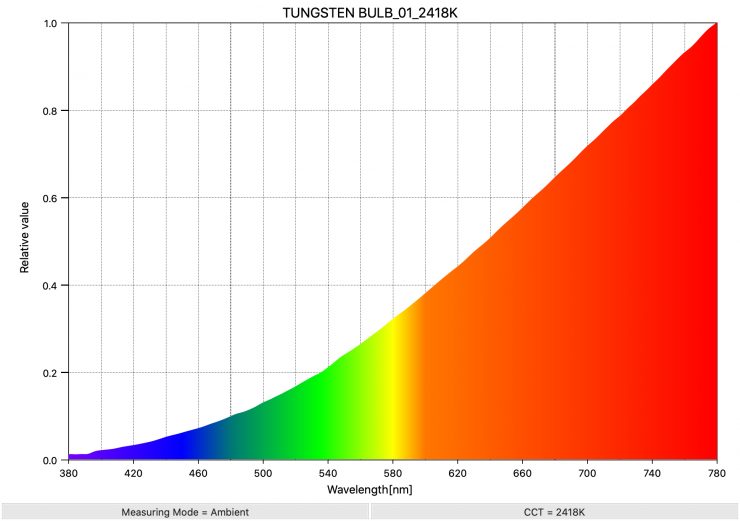
As a comparison, above you can see what the spectral response of a tungsten light bulb looks like.
Real-World Performance and Quality of Light

As I always say, photometric scores only tell you part of the story. So do the scores from the MEGA-8 LITECLOTH 3.0 translate into real-world performance? The simple answer is yes. The quality of the light that is coming from the MEGA-8 is really nice.

As far as how the light looks, it really does produce a beautiful large soft source. With the included diffusion you get this lovely quality of light.

Above you can see a few frames where the only light being used on the subject is the MEGA-8 LiteCloth 3.0. It is positioned above and to the right of the subject.
Now, I apologize if my tests are a little crude as I am trying to use this large light in a very small place.
I found that even without using any diffusion at all I could still create a very flattering light source. In my opinion, you just can’t beat a large source if your ultimate aim is to produce soft, even light with no shadows.
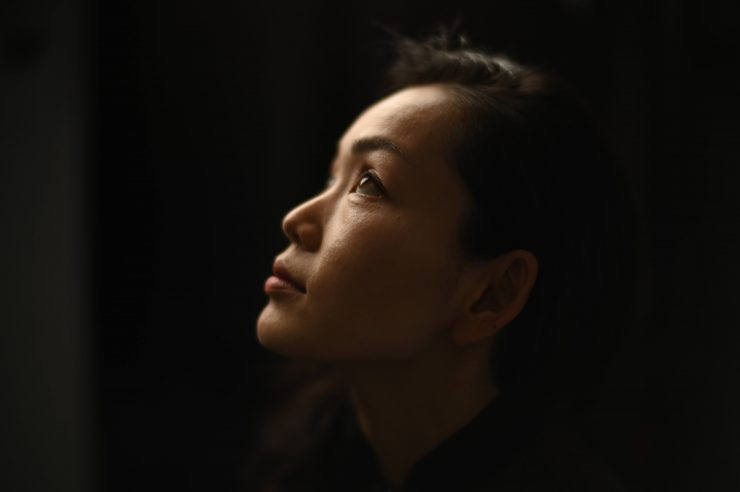
In the example above I have the light on my subject bouncing into a silver scrim.
I also found it really nice to have a large source with lots of output. This light certainly punches above its weight and I found that it could easily be used instead of a powerful 2×1 LED light that is being punched through diffusion.


Light On 
Light Off
Above you can see just how much output the light has when used with its optional Lantern. I have kept the exact same camera settings for both shots.

The included diffusion isn’t super strong, but because it is now further away from the light source it is softer than when using the previous version. If you want to create even softer light I would recommend getting the optional 1 stop diffusion and using it instead or doubling it up with the stock diffusion to create 1.5 stops.

You can create super soft light using the diffusion and placing it above your subject or over a table, etc. Above you can see a few quick frames where the light is placed directly above a table. You can see how nice and even the light is and how you get very soft shadows. By using it with or without the honeycomb grid, you can choose how much spill you want.

As the light is a flexible panel, you can also bend it in half and have one side of the light facing one direction and the other side of the light facing the opposite direction. This makes for a very quick and easy solution if you need to light the interviewer and the interviewee with a limited amount of lights and time.

Above all I have done is to put the light on a boom stand positioned sideways by placing the elastic corners of the boom arm. I then use another stand at the front to create the v shape. The only problem with this solution is when it comes to the diffusion. As you can’t use it with the diffusion frame when positioned like this you have to place the diffusion close to the light. I would recommend using two layers of diffusion if you configure the light in this type of position.

You could also use two boom arms or other solutions if you needed to place the light higher and further out, but still light two people at once. Yes, this is a crude example, but often lighting can be about making do with what you have at your disposal.

Above you can see that I am able to light two people at once using this solution with just a single light. Is it perfect, no, but it does show you how versatile a light like the MEGA-8 LITECLOTH 3.0 is.
I also found you could create a nice book light by punching the MEGA into a white/silver scrim and then back through the included diffusion frame.

The optional Lantern for the MEGA-8 works really well and I highly recommend it. You can create a very soft and broad spread of light using the lantern.

You create the lantern shape by connecting up little flexible poles that fit together.

If you need to limit the spill you can attach the skirt that comes with it.

You can roll up and change the skirt depending on how much spill you want to create.

It is also nice to be able to create saturated colors using the HSI mode.
The very wide beam angle certainly makes it a very versatile fixture. You can use it to indirectly bounce light into a ceiling or a wall and it produces a nice indirect lighting source. If you just need brute power it also works well.
I like that I can use the lights via mains power or through V-lock camera batteries without sacrificing output.
Who is the MEGA-8 LITECLOTH 3.0 aimed at?
You could use the MEGA-8 LITECLOTH 3.0 for lots of different applications, but the light is certainly being targeted as a high output, portable light source that can be used either indoors or outdoors.
Whether the MEGA-8 LITECLOTH 3.0 is likely to appeal to solo shooters and small crews who are looking for a travel-friendly and affordable large lighting solution is debatable. I personally think it could be used in that capacity given its output, with the only real caveats being the size and weight if you put everything in the included case. You could easily strip the light down and not take it in the large travel case and just use some common light stands to hold it up.
Alternative Solutions

Other alternatives include the recently announced Godox 600Bi Bi-Color LED Light Panel. This light draws a lot more power (670W compared to the 400W) than the Intellytech. It also comes with a standard x-frame and not a solid frame. The Intellytech is also available in RGBWW, while the Godox only comes in Bi-color. The Godox 600Bi Bi-Color LED Light Panel retails for $1,749 USD, while the Intellytech Mega-8 Litecloth 3.0 Bi-Color LED Flexible Mat (V-Mount) costs $1,849 USD.
There is also the Aladdin MOSAIC 3×6 RGBWW LED Panel Kit, which retails for a whopping $7,701.43 USD.
Optional Accessories
Intellytech makes a few accessories for the MEGA-8 LITECLOTH 3.0:
- MEGA-8 PANCAKE LANTERN & SKIRT $185.00 USD
- 13′ HEADER EXTENSION CABLE FOR MEGA-6 & MEGA-8 LITECLOTH 3.0 $46.75 USD
- 26′ HEADER EXTENSION CABLE FOR MEGA-6 & MEGA-8 LITECLOTH 3.0 $63.00 USD
- 1 Stop Diffuser – Mega-8 $35.00 USD
Price
The Intellytech Mega-8FC Litecloth 3.0 RGB LED Flexible Mat (V-Mount) is available for $2,249 USD.
The Mega-8FC Litecloth 3.0 RGB LED Flexible Mat (V-Mount) is well-priced and you certainly get a lot of value for money. If you think of the light as 8 individual 1×1 panels you are essentially only paying around $281 USD for each panel.
I personally think it offers good value for money considering what you get for your $2,249 USD.
The Intellytech Mega-8 Litecloth 3.0 Bi-Color LED Flexible Mat (V-Mount) costs $1,849 USD.
Conclusion
The Intellytech Mega-8FC Litecloth 3.0 RGB LED Flexible Mat (V-Mount) could very well be one of my favorite lighting products of the year. If you are going to come out with a new version of a product, then it needs to be better. Intellytech has improved and changed so many elements of the fixture and its design, and it is more than just a worthy successor to the original.
It produces a beautiful soft light, especially with two layers of diffusion. The extra output it has over the previous version is a welcome addition, and it is the extra output that really helps when you want to create a more diffused lighting source, but you still require a decent amount of punch. The only downside with the increased output, as I mentioned earlier in the review, is that it comes with the caveat of an increased power draw. At 400W it is no longer able to be powered via two flight-safe batteries. This is something you need to consider.
The optional Lantern creates beautiful light and it is reasonably priced. I would recommend getting it if you plan on purchasing the MEGA-8.
The photometric scores across the board are impressive and the light has essentially the same output at almost all of its CCT settings. The biggest caveat is when it comes to using the diffusion. You need to be aware of how much it alters the CCT and adjust the fixture accordingly. If there is one thing I would like to see Intellyteh improve on it is to come up with some better diffusion material.
It is well made and designed, and Intellytech improved on all of the aspects that I had issues with when I reviewed the previous version. I like the new diffusion screen frame and the fact that you can now place the diffusion further away from the LEDs. The only downside to this new design is that it does take slightly longer to set up the light.
It is a highly versatile lighting solution that can be used in numerous different ways and that is one of its biggest appeals. Being able to create such a broad lighting source from a fixture that doesn’t require massive lighting stands and numerous people to move it around only adds to its versatility.
No one light is going to be suitable for every application, but you ideally want to buy fixtures that are multi-versatile. COB spotlights which are all the rage right now, can’t do what this light can. Being able to create a large lighting source in an easy-to-use, lightweight solution is no easy task. Intellytech has done a very good job with this new fixture and it comes highly recommended.









